Thoughts on Generative Music - Part 1
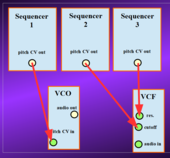
(includes embedded videos) If you want to support my work, please make use of the "PayPal" button - thank you very much indeed!
When you read a guide to generative music you quickly understand: producing generative music is always a bit like walking the line between perfect chaos and all too clearly structured musical progressions.
And that is where a generative sequencer VST can step in and give us a helping hand to find this small path between brilliancy and razzle-dazzle.
It´s because of the way how generative music works, that it´s hard to find an appropriate place to put in our compositional will – appropriate in the process of producing generative music as well as appropriate in the musical piece itself.
Alright,let´s go for it.
The techniques for generative music that I´m going to talk about in this article and in the whole series don´t work only for generative music VSTs, but also for hardware modular synths, even if most generative VSTs are equipped with more functionality than their hardware brothers and sisters.
Let me start with very basic sequencers only. There are two systematically different approaches to use basic sequencers in generative music: using them to generate musical structure or using them to impose structure on musical material, which is generated somewhere else in the process.
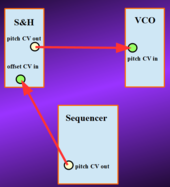
Two short examples to illustrate what I mean. The musical material in the first example comes from a sample and hold unit modulating an audio oscillator. The results are completely random and chaotic. But then I use a sequencer, which produces only two pitch CVs (the one belonging to the note C4 and the other one belonging to the note C6) to impose a structure to the output of the sample and hold unit. I do so by modulating the offset of the sample and hold unit with the sequencers pitch CV output. As a result the still randomly generated pitches are alternately clustering in higher pitch regions and in lower pitch regions.
Just click the link to see and hear this little patch in action.
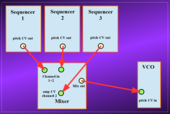
In example two there are 3 sequencers, which generate the musical material together with an audio oscillator. The pitch CV output of 2 sequencers, which run at slightly different clock rates are mixed together. The resulting CVs modulate the pitch of the audio oscillator. Additionally a third sequencer modulates the share, which each of the first two sequencers have in the resulting pitch CV. This third sequencer runs at a clock rate different from the rates of sequencers 1 and 2. https://youtu.be/w4LeFJ-n-4Y
Please notice, that only basic sequencer functionality is used in both examples. And I´ll continue using only basic sequencers (respectively only basic sequencer functions) in this part 1 of my series of articles about generative music.
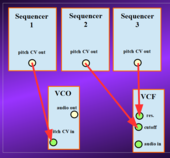
Let me team up 3 sequencers again. But this time each of them modulates a different parameter of the generated sound: pitch, filter resonance and filter cutoff. The sequencer, which modulates the filter´s resonance modulates the clock of the pitch CV sequencer at the same time. To make things a bit nicer I have inserted a bit of reverb in the audio path.
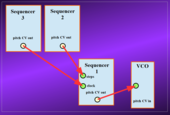
In the next example there is only 1 pitch CV sequencer. A second sequencer modulates the number of steps of this pitch sequencer, and a third sequencer modulates the pitch sequencer´s clock.
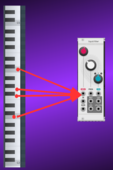 Let say a word about why using sequencers for these tasks before I show some more complex examples. I could use LFO – quantizer combinations as well. Or a lot of other methods. But using sequencers haa one huge advantage: sequencers enable me to really compose generative musical progressions, by setting up the underlying algorithms in a very musical way – may I say: in a rather “classic” way? And think about that: by adjusting the CV of each step according to note names I could – or even should? - start thinking of how to translate classic rules of composition (pitch, melody, chords, intervals) to modulating parameters like time, clock rates, cutoff frequencies, resonances, step numbers etc. Does it eventually make sense to apply the CV progression belonging to the pitch CV of the phrase C-F-G-C to a clock rate instead of patching it to the pitch CV input of an audio oscillator? Is there something like a “cadence of clock rates” ? Or of resonances? Well, have our sequencers at hand we are able to find out.
Let say a word about why using sequencers for these tasks before I show some more complex examples. I could use LFO – quantizer combinations as well. Or a lot of other methods. But using sequencers haa one huge advantage: sequencers enable me to really compose generative musical progressions, by setting up the underlying algorithms in a very musical way – may I say: in a rather “classic” way? And think about that: by adjusting the CV of each step according to note names I could – or even should? - start thinking of how to translate classic rules of composition (pitch, melody, chords, intervals) to modulating parameters like time, clock rates, cutoff frequencies, resonances, step numbers etc. Does it eventually make sense to apply the CV progression belonging to the pitch CV of the phrase C-F-G-C to a clock rate instead of patching it to the pitch CV input of an audio oscillator? Is there something like a “cadence of clock rates” ? Or of resonances? Well, have our sequencers at hand we are able to find out.
But back to more playful things. I promised a more complex example, well, here it is:
There are 4 sequencers in the patch. Sequencer 1 modulates the cutoff frequency of the filter as well as the clock rate of sequencer 2. This sequencer 2 modulates the filter resonance as wll as the pitch of the audio oscillator. But it does the latter together with sequencer 3 (both pitch CV outputs are fed in a mixer). But it´s not only the clock rate of sequencer 2, that´s modulated. It´s also the number of steps of sequencer 2, which is modulated by sequencer 4. The clock rate of this sequencer 4 is modulated by sequencer 3 (the one which in company with sequencer 2 modulates the audio oscillator´s pitch). https://youtu.be/QqLI75y_VsA
... to be continued.
Click here to get a comprehensive introduction to making generative music:
https://www.dev.rofilm-media.net/node/331
to part 2: https://www.dev.rofilm-media.net/node/343
to part 3: https://www.dev.rofilm-media.net/node/344
to part 4: https://www.dev.rofilm-media.net/node/358
to part 5: https://www.dev.rofilm-media.net/node/365
to part 6: https://www.dev.rofilm-media.net/node/374
to part 7: https://www.dev.rofilm-media.net/node/381
to part 8: https://www.dev.rofilm-media.net/node/386
to part 9: https://www.dev.rofilm-media.net/node/391
to part 10: https://www.dev.rofilm-media.net/node/404
to part 11: https://www.dev.rofilm-media.net/node/408
to part 12: https://www.dev.rofilm-media.net/node/415
to part 13: https://www.dev.rofilm-media.net/node/425
to part 14: https://www.dev.rofilm-media.net/node/427

Add new comment